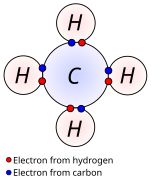Chemical bond
2. In (a) the two nuclei are surrounded by a cloud of two electrons in the bonding orbital that holds the molecule together. (b) shows hydrogen's antibonding orbital
A chemical bond is the association of
Since opposite
The atoms in molecules, crystals, metals and other forms of matter are held together by chemical bonds, which determine the structure and properties of matter.
All bonds can be described by
Overview of main types of chemical bonds
A chemical bond is an attraction between atoms. This attraction may be seen as the result of different behaviors of the outermost or
In the simplest view of a
In a
In a simplified view of an
A less often mentioned type of bonding is
History

Early speculations about the nature of the chemical bond, from as early as the 12th century, supposed that certain types of
In 1819, on the heels of the invention of the
However the nature of the atom became clearer with
Nagaoka's model made two predictions:
- a very massive atomic center (in analogy to a very massive planet)
- electrons revolving around the nucleus, bound by electrostatic forces (in analogy to the rings revolving around Saturn, bound by gravitational forces.)
Rutherford mentions Nagaoka's model in his 1911 paper in which the atomic nucleus is proposed.[12]
At the 1911 Solvay Conference, in the discussion of what could regulate energy differences between atoms, Max Planck stated: "The intermediaries could be the electrons."[13] These nuclear models suggested that electrons determine chemical behavior.
Next came
Also in 1916,
In 1927, the first mathematically complete quantum description of a simple chemical bond, i.e. that produced by one electron in the hydrogen molecular ion,
In 1933, H. H. James and A. S. Coolidge carried out a calculation on the dihydrogen molecule that, unlike all previous calculation which used functions only of the distance of the electron from the atomic nucleus, used functions which also explicitly added the distance between the two electrons.[19] With up to 13 adjustable parameters they obtained a result very close to the experimental result for the dissociation energy. Later extensions have used up to 54 parameters and gave excellent agreement with experiments. This calculation convinced the scientific community that quantum theory could give agreement with experiment. However this approach has none of the physical pictures of the valence bond and molecular orbital theories and is difficult to extend to larger molecules.
Bonds in chemical formulas
Because atoms and molecules are three-dimensional, it is difficult to use a single method to indicate orbitals and bonds. In
Strong chemical bonds
| Typical Å by division by 100 (1 Å = 100 pm). | ||
| Bond | Length (pm) |
Energy (kJ/mol) |
|---|---|---|
| H — Hydrogen | ||
| H–H | 74 | 436 |
| H–O | 96 | 467 |
| H–F | 92 | 568 |
| H–Cl | 127 | 432 |
| C — Carbon | ||
| C–H | 109 | 413 |
| C–C | 154 | 347 |
| C–C= | 151 | |
| =C–C≡ | 147 | |
| =C–C= | 148 | |
| C=C | 134 | 614 |
| C≡C | 120 | 839 |
| C–N | 147 | 308 |
| C–O | 143 | 358 |
| C=O | 745 | |
| C≡O | 1,072 | |
| C–F | 134 | 488 |
| C–Cl | 177 | 330 |
| N — Nitrogen | ||
| N–H | 101 | 391 |
| N–N | 145 | 170 |
| N≡N | 110 | 945 |
| O — Oxygen | ||
| O–O | 148 | 146 |
| O=O | 121 | 495 |
| F, Cl, Br, I — Halogens | ||
| F–F | 142 | 158 |
| Cl–Cl | 199 | 243 |
| Br–H | 141 | 366 |
| Br–Br | 228 | 193 |
| I–H | 161 | 298 |
| I–I | 267 | 151 |
Strong chemical bonds are the intramolecular forces that hold atoms together in
The types of strong bond differ due to the difference in
Ionic bond
Ionic bonding is a type of electrostatic interaction between atoms that have a large electronegativity difference. There is no precise value that distinguishes ionic from covalent bonding, but an electronegativity difference of over 1.7 is likely to be ionic while a difference of less than 1.7 is likely to be covalent.
Ionic crystals may contain a mixture of covalent and ionic species, as for example salts of complex acids such as
When such crystals are melted into liquids, the ionic bonds are broken first because they are non-directional and allow the charged species to move freely. Similarly, when such salts dissolve into water, the ionic bonds are typically broken by the interaction with water but the covalent bonds continue to hold. For example, in solution, the cyanide ions, still bound together as single CN− ions, move independently through the solution, as do sodium ions, as Na+. In water, charged ions move apart because each of them are more strongly attracted to a number of water molecules than to each other. The attraction between ions and water molecules in such solutions is due to a type of weak dipole-dipole type chemical bond. In melted ionic compounds, the ions continue to be attracted to each other, but not in any ordered or crystalline way.
Covalent bond

Covalent bonding is a common type of bonding in which two or more atoms share
In non-polar covalent bonds, the electronegativity difference between the bonded atoms is small, typically 0 to 0.3. Bonds within most organic compounds are described as covalent. The figure shows methane (CH4), in which each hydrogen forms a covalent bond with the carbon. See sigma bonds and pi bonds for LCAO descriptions of such bonding.[22]
Molecules that are formed primarily from non-polar covalent bonds are often
A
Single and multiple bonds
A single bond between two atoms corresponds to the sharing of one pair of electrons. The Hydrogen (H) atom has one valence electron. Two Hydrogen atoms can then form a molecule, held together by the shared pair of electrons. Each H atom now has the noble gas electron configuration of helium (He). The pair of shared electrons forms a single covalent bond. The electron density of these two bonding electrons in the region between the two atoms increases from the density of two non-interacting H atoms.

A double bond has two shared pairs of electrons, one in a sigma bond and one in a pi bond with electron density concentrated on two opposite sides of the internuclear axis. A triple bond consists of three shared electron pairs, forming one sigma and two pi bonds. An example is nitrogen. Quadruple and higher bonds are very rare and occur only between certain transition metal atoms.
Coordinate covalent bond (dipolar bond)

A
Metallic bonding
In metallic bonding, bonding electrons are delocalized over a lattice of atoms. By contrast, in ionic compounds, the locations of the binding electrons and their charges are static. The free movement or delocalization of bonding electrons leads to classical metallic properties such as
Intermolecular bonding
There are several types of weak bonds that can be formed between two or more molecules which are not covalently bound. Intermolecular forces cause molecules to attract or repel each other. Often, these forces influence physical characteristics (such as the melting point) of a substance.
Van der Waals forces are interactions between closed-shell molecules. They include both Coulombic interactions between partial charges in polar molecules, and Pauli repulsions between closed electrons shells.[23]: 696
Keesom forces are the forces between the permanent dipoles of two polar molecules.[23]: 701 London dispersion forces are the forces between induced dipoles of different molecules.[23]: 703 There can also be an interaction between a permanent dipole in one molecule and an induced dipole in another molecule.[23]: 702
Hydrogen bonds of the form A--H•••B occur when A and B are two highly electronegative atoms (usually N, O or F) such that A forms a highly polar covalent bond with H so that H has a partial positive charge, and B has a lone pair of electrons which is attracted to this partial positive charge and forms a hydrogen bond.[23]: 702 Hydrogen bonds are responsible for the high boiling points of water and ammonia with respect to their heavier analogues. In some cases a similar halogen bond can be formed by a halogen atom located between two electronegative atoms on different molecules.
At short distances, repulsive forces between atoms also become important.[23]: 705-6
Theories of chemical bonding
In the (unrealistic) limit of "pure"
Covalent bonds are better understood by
Unlike the spherically symmetrical Coulombic forces in pure ionic bonds, covalent bonds are generally directed and
References
- S2CID 222157102.
- S2CID 121366097.
- from the original on Apr 8, 2023.
- ISBN 978-0-471-98425-2.
- ISBN 978-0801403330.
- ISBN 0130-39913-2.
- S2CID 97871973.
- ISBN 0130-39913-2.
- ^
ISBN 0-7679-0817-1.
- ^ The Genesis of the Bohr Atom, John L. Heilbron and Thomas S. Kuhn, Historical Studies in the Physical Sciences, Vol. 1 (1969), pp. vi, 211-290 (81 pages), University of California Press.
- ^ Original Proceedings of the 1911 Solvay Conference published 1912. THÉORIE DU RAYONNEMENT ET LES QUANTA. RAPPORTS ET DISCUSSIONS DELA Réunion tenue à Bruxelles, du 30 octobre au 3 novembre 1911, Sous les Auspices dk M. E. SOLVAY. Publiés par MM. P. LANGEVIN et M. de BROGLIE. Translated from the French, p. 127.
- ISBN 978-0-19-851971-3.
- (PDF) from the original on 2018-07-18.
- ISBN 978-0-19-855919-1.
- ISBN 978-981-02-2771-5. Retrieved 2012-02-05.
- .
- ^ "Bond Energies". Chemistry Libre Texts. 2 October 2013. Retrieved 2019-02-25.
- ISBN 978-0-7167-3107-8.
- OCLC 24501305.
- ^ ISBN 0-7167-3539-3.
- ^ Ouellette, Robert J.; Rawn, J. David (2015). "Polar Covalent Bond". Science Direct. Retrieved 14 September 2023.
A polar covalent bond exists when atoms with different electronegativities share electrons in a covalent bond.
External links
- W. Locke (1997). Introduction to Molecular Orbital Theory. Retrieved May 18, 2005.
- Carl R. Nave (2005). HyperPhysics. Retrieved May 18, 2005.
- Linus Pauling and the Nature of the Chemical Bond: A Documentary History. Retrieved February 29, 2008.



